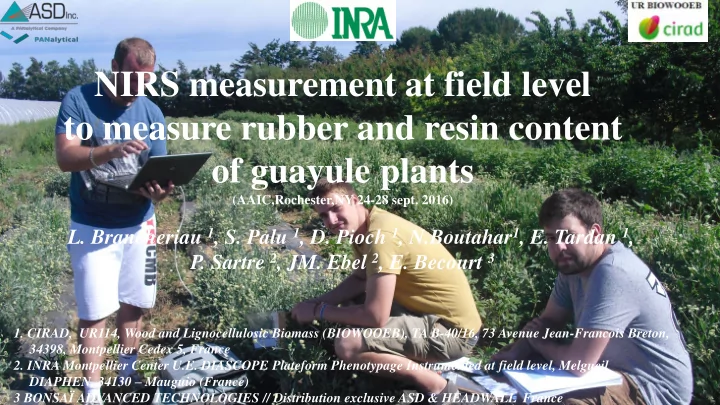

NIRS measurement at field level to measure rubber and resin content of guayule plants (AAIC,Rochester,NY 24-28 sept. 2016) L. Brancheriau 1 , S. Palu 1 , D. Pioch 1 , N.Boutahar 1 , E. Tardan 1 , P. Sartre 2 , JM. Ebel 2 , E. Becourt 3 1. CIRAD, UR114, Wood and Lignocellulosic Biomass (BIOWOOEB), TA B-40/16, 73 Avenue Jean-Francois Breton, 34398, Montpellier Cedex 5, France 2. INRA Montpellier Center U.E. DIASCOPE Plateform Phenotypage Instrumented at field level, Melgueil DIAPHEN, 34130 – Mauguio (France) 3 BONSAÏ ADVANCED TECHNOLOGIES // Distribution exclusive ASD & HEADWALL France
CONTENT Research activities on Guayule at CIRAD/UR Biowooeb Materials and Methods Résults Conclusion & Perspectives
Interest of NIRS measurement applied to guayule resins and rubber quantification Help geneticians for the search of most performing lines of guayule plants, Follow up field production and best time to harvest, Fast and accurate determination of rubber and resins production per hectare
CIRAD ACTIVITIES ON GUAYULE IN FRANCE Planting in Lansargues-Mauguio (2014) and Claira-Perpignan (2013). Follow-up EU- PEARLS guayule experimental field in Cartagena. Seeds collection. EUNARS-G commitment (2014) with ETRMA/WUR/CTTM/VERSALIS/MAPA with a target to replace 10% of NR imports from Asia (120.000 T.) by GR (200.000 ha) by 2030. Fast Track Innovation (FTI) project proposal (October 2016) : guayule planting (5-10 ha) in Andalucia/Huelva,Spain; building of a latex and resins extraction guayule pilot plant in 2017. FEADER (EU & LR regional funded) project with more guayule planting in France (>2ha) on four locations with farmers in South of France (LR and PO). Extension of guayule cultivation in Tunisia and Morocco (2017).
GUAYULE ( Parthenium argentatum ) Guayule is adapted to Mediterranean climate (South of EU and North of Africa)
Lansargues/Mauguio Cartagena/Spain France (EU-PEARLS) (2014) 2009 Claira/Perpignan France (2012)
PI ( 25-35%
MATERIALS AND METHODS
TYPE OF EQUIPMENT USED ASE 350 (Dionex/Thermofisher) Détermination of a reference method for extraction of resins and PI) PhD Sunisa SUCHAT ( 2012) NIRS Laboratory VECTOR V22 ( Brucker) NIRS field portable ASD (LabSpec4)
ADVANTAGES OF NIRS MEASUREMENT Source Phd Sunisa Suchat
The NIRS method is based on the Phenomenon that functional groups such as C-H, N-H and O-H absorb near infrared light
Interpretation of NIRS spectra Moisture : 1450 nm /1940 nm Strain of link O-H of H 2 O Polyisoprène : 1716 nm Strain of link C-H of – CH 3 Résines : 2210 nm Strain of the link – C=O of a carboxyle group 2308 nm Strain and distorsion of the link – C-H of – CH 2 from a lipid Source PhD Sunisa Suchat
METHODOLOGY Laboratory : (Vector V22 Brucker) Branches samples dried ( moisture < 9%) and size particles<500µm) Scan reflectance mode : 400nm à 2500nm (interval 2nm) Average of 32 spectra with correction of light dispersion Calculation of seconde derivative for 5 points polynomial lissage PLS regression used to establish calibration curves SECV calculation with predicton on 25% of samples with a calibration developed with 75% remaining samples Field and Laboratory : (ASD Labspec4) - Use of a reflectance probe - 5 spectra per branche and 10 branches per plant , or 50 spectra per plant TOTAL: 70 branches selected or 350 NIRS measurements at field level to establish a model LAB NIRS /FIELD NIRS.
PRINCIPLE OF NIRS MEASUREMENT 2.NIRS Field Lab + 3. NIRS lab Vector V22 Portable ASD (LabSpec4) Brucker 4.ASD (Dionex) 6. Calibration 5.Mathematical Equation, analysis Validation
RESULTS
CONCLUSION & PERSPECTIVES
Capability to determine by NIRS measurement , guayule resin content directly by field mesurement (non destructive and fast determination); Uncertainity of determination of ± 0.8 for a resin content range of 4% to 12%; Model for polyisoprene less efficient with an uncertainity of 1,2% for a rubber content range of 3% to 10%; Need to increase the number of measurements to improve the data base and to build more powerful models; Need to investigate the best area of NIRS measurement on a guayule plant, the ffect of seasonality on NIRS measurement, the relationship between the depth of NIRS measurement and the presence of polyisoprene.
Recommend
More recommend